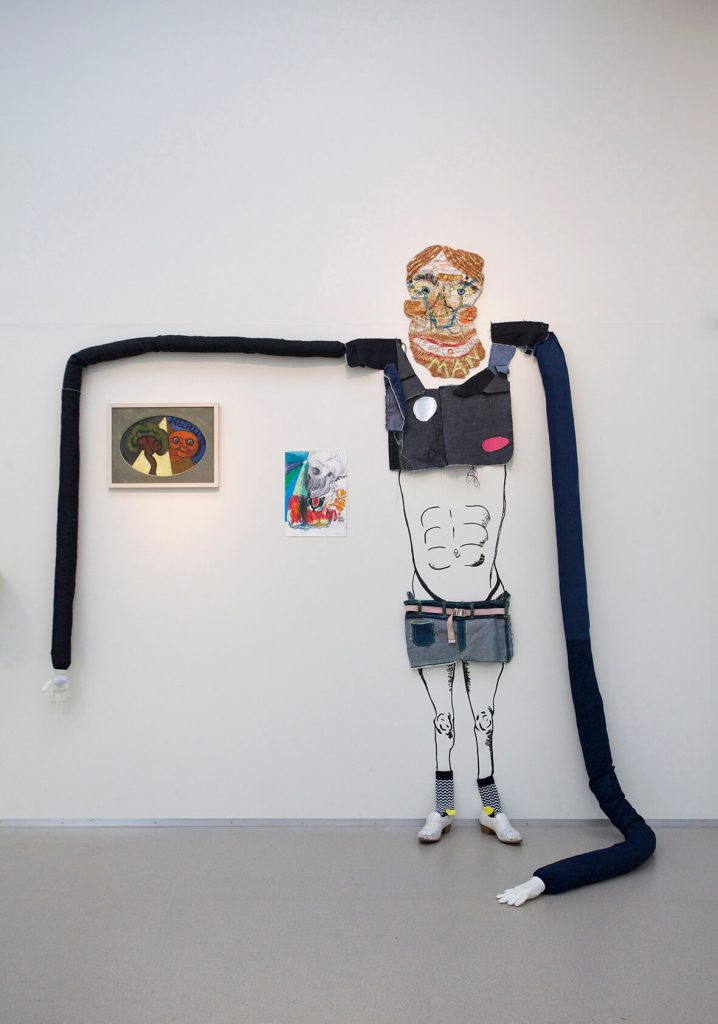Radicale Sociale Animale Talen is a large-scale exhibition at the Cobra Museum, which loosely explores a number of themes that were relevant to the CoBrA movement. These themes continue to inspire today’s artists, since they have always maintained their artistic and social urgency.
FREEDOM AND ENGAGEMENT

‘Liberation’ and ‘freedom’ were important terms in CoBrA’s vocabulary. The new form of art advocated by artists was intended to go beyond liberating artists from academic rules; it would also release the human spirit from its passive state. This section of the exhibition includes work where unrestrained, almost childlike spontaneity has been a source of inspiration. Erik Van Lieshout is showing his video installation ‘The Island’ (2016). It is an account of the several months the artist spent on an island in a lake near Dortmund, where he passed most of his time in self-imposed isolation. The attitude and the temporary structures which Van Lieshout made on the island evoke memories about the work of CoBrA member Henry Heerup, an artist who deliberately presented himself in the ironic role of a naive fool, with bare torso and pointy elf hat. The work of Jonas Ohlsson, another contemporary artist in this section, is rooted in social and political engagement, and his interest in the relationship between popular culture and building communities. The exhibition includes results of a recent residency at the European Ceramic Work Center, where he produced a series of experimental ceramics which reflect his intuitive and direct way of working in this slow medium.
WORD AND IMAGE

Artists and poets in the CoBrA group regularly combined image and text to produce a single integrated piece of work. Christian Dotremont coined the term peinture-mots (word paintings), and he made such works with various collaborators, including Asger Jorn and Pierre Alechinsky. Collaboration and a cross-disciplinary approach were at the heart of CoBrA’s philosophy. In this exhibition section, writer, poet and artist Maria Barnas presents her work ‘The Speech’. Barnas is interested in language as ‘material’, a malleable element which can be used to make and recall images. Since 1996, Richard Niessen has been working on an oeuvre which he calls ‘Typographic Masonry’. His work involves introducing an amalgam of characters, symbols and ornaments into three-dimensional structures with a non-linear logic. Richard Niessen created the ‘Asemic Cabinet’ for this exhibition..
MATTER

Courtesy the artist, Galerie Max Hetzler Paris
CoBrA’s artistic project was based on a candid confrontation with the world of matter and the creative spirit. The resulting works of art are generally a dialogue between the artist, the materials available, and the tools used by the artist. This section of the exhibition includes work by Karel Appel and Asger Jorn, both of whom are perhaps the most obvious representatives of the urge to experiment with materials within the CoBrA movement. This playful and inquisitive approach to different materials is clearly reflected in the work of Navid Nuur, which is also on display in this section. His recent series ‘Rituals of the Rational’ seems to be based on a curiosity about chemical processes and alchemical transformation. Another perspective taken from CoBrA’s ideas about using materials is provided by Raphaela Vogel. Her work on display in this exhibition is titled Mogst mi du ned, mog i di, and is an installation comprising video, sound, and objects.
Radicale Sociale Animale Talen is an exhibition with a trans-historical character. It brings together works of art from different periods and cultural contexts which share similar attitudes and themes, and illustrates artistic connections which transcend the decades. It means that the present can be looked at using CoBrA as a lens, and conversely CoBrA is opened up to new interpretations. Based on the existing architectural structure and with minimal resources, Gabriel Lester/Polylester developed a modular exhibition architecture.
